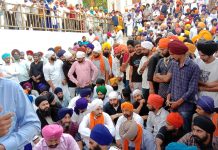WASHINGTON DC—Responding to House Resolution 6916, a proposal to posthumously award Mohandas Gandhi a Congressional Gold Medal, a new video documents the Indian icon’s relationship with black people during his 21 years as a lawyer in colonial South Africa.
“Shortly before Apartheid criminalized racial harmony in South Africa, Gandhi took legal action to segregate Africans from Indians,” explains African activist Jada Bernard in the video. “He demanded segregated schools, segregated neighborhoods, segregated prisons. He even successfully sued to get a third door installed in the Durban, South Africa post office so Indians wouldn’t have to share a door with blacks.”
Working through Gandhi’s time in South Africa by quoting from The Collected Works of Mahatma Gandhi, Bernard concludes, “What if the truth is that we’ve been double-victimized? First, the living Gandhi pushed a racist agenda to oppress us. Second, the dead Gandhi was passed off as a hero for the African people.”
Commenting on the video, which was produced by Organization for Minorities of India (OFMI), Arvin Valmuci says, “Members of the U.S. Congress should really take note of who they are attempting to honor before they pass this resolution.”
A spokesperson for OFMI, Valmuci continues, “We demand that the handful of representatives who have co-signed this resolution immediately remove their support. Especially Representative Tulsi Gabbard. After national pressure compelled Gabbard to back out of the World Hindu Congress and admit that it was an Indian political event, we hope she wakes up to the reality that this resolution is also sponsored by a foreign government. Why else was the Indian consulate involved when Rep. Carolyn Maloney of New York announced she would introduce legislation in the American Congress?”
In the video, presenter Bernard makes the following remarks:
“People call him an Apostle of Nonviolence. World leaders visit the spot where he was cremated. His Hollywood story has won Academy Awards. We see his statues all over the world.
Now, an American Congresswoman even wants to give him a Congressional Gold Medal.
But who was Gandhi?
He told us, “My life is my message.”
Has his life been told correctly?
He warned us that his life was a story of experiments with truth.
Do we know the result of those experiments?
Do we know the truth?
After graduating law school in England, Gandhi spent 21 years as a lawyer in colonial South Africa.
What did he do during these pivotal years?
What if I told you that Gandhi used his talents to advance white supremacy?
Shortly before Apartheid criminalized racial harmony in South Africa, Gandhi took legal action to segregate Africans from Indians. He demanded segregated schools, segregated neighborhoods, segregated prisons. He even successfully sued to get a third door installed in the Durban, South Africa post office so Indians wouldn’t have to share a door with blacks.
Why would he do this? We thought that Gandhi aligned himself with the marginalized, empowered the oppressed, and worked to uplift the downtrodden. But what did he believe about melanated people like me?
He believed that life is a competition between races and that Indians must rise above Africans in order to progress in this world.
Gandhi called black Africans “Kaffirs” — a racial slur that will get you arrested if you use it today in South Africa. He said that “Indians are undoubtedly infinitely superior to the Kaffirs.”
He said that blacks “are of no use,” and “do not work at all,” and are “as a rule uncivilized.” He used every stereotype in the book to push his hatred of blacks. The “sole ambition” of an African, according to Gandhi, was “to collect a certain number of cattle to buy a wife with and then pass his life in indolence and nakedness.”
He knew that blacks were suffering in South Africa. He said, “Prejudice against Kaffir races, in a strong form, was in existence.” But he was only concerned about prejudice against Africans because he was concerned that Indians were being “lumped together” with blacks. Gandhi hated being identified with blacks.
He said that being “classed with the natives of South Africa — the Kaffir race” was a “gross injustice” and “insulted the Indians.” He was scared of being “dragged down with the Kaffir.” He was terrified that “there will be no difference between Indians and Kaffirs.”
He wanted to convince whites that “both the races — Indian and European — have sprung from the same Aryan stock.” So he assured them that there are “evident and sharp distinctions” between Africans and Indians. He said that Indians are “scholars and gentlemen,” and claimed that “one cannot but help regretting that the children of such a race should be treated as equals of the children of black heathendom and outer darkness.”
Gandhi would not tolerate sharing any space in this world with blacks. He was furious that Indian children had to share a school with African children and called it “unjust to the Indian community.” When blacks moved into Indian neighborhoods, he said, “This mixing of the Kaffirs with the Indians is very unfair to the Indian population.” He protested that “all the Kaffirs of the town” are being “dumped down” in Indian neighborhoods, and so he petitioned the government to “withdraw the Kaffirs.”
The strangest part is that Gandhi wasn’t even asking for Indians to be treated equal to whites. He just wanted to make sure that Indians were treated superior to Africans.
He wrote letters to the colonial government to protest against “the co-mingling of the colored and white races.” He assured them that Indians “cherish… the purity of type.” He was very specific. Indians, said, Gandhi, advocate “the purity of all the races and not one alone.”
Above all, Gandhi wanted to preserve white supremacy. So he told the government, “We believe that the white race of South Africa should be the predominating race.”
Gandhi’s racism is one of the main reasons why he was denied the Nobel Peace Prize — not just once or twice — but five times.
Gandhi’s racism is one reason why the Dalits — the black people of India — felt that he was their enemy. It’s why the Dalit intellectual Dr. Ambedkar said, “I met Mr. Gandhi in the capacity of an opponent” and warned “he opened his real fangs to me.”
Was Gandhi really a champion of civil rights?
Why is the only statue at the Dr. Martin Luther King., Jr. Center in Atlanta a statue of Gandhi?
We’re told that Dr. King was inspired by Gandhi, but the reality is that Dr. King only praised Gandhi in passing — and in ignorance. What if King had known the real face of Gandhi?
Maybe he would have reacted the same way as the professors at the University of Ghana, who successfully demanded a removal of a Gandhi statue from their campus.
What if the truth if that we’ve been double-victimized?
First, the living Gandhi pushed a racist agenda to oppress us. Second, the dead Gandhi was passed off as a hero for the African people.
That’s like rubbing salt in our wounds — wounds which have not yet healed from the pain of centuries of oppression, slavery, apartheid, lynching, and segregation.
What if the story we think is really true is really propaganda?
What if we’ve been fed poison passed off as sugar?
What if Gandhi was actually a champion of racial inequality?”





